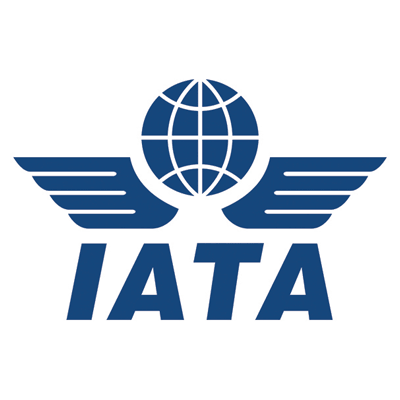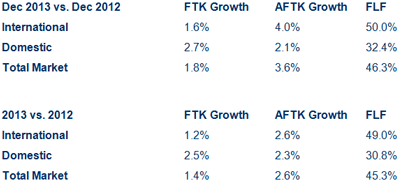Moderate growth for air cargo in 2013 full year performance statistics released
- Like
- Digg
- Del
- Tumblr
- VKontakte
- Buffer
- Love This
- Odnoklassniki
- Meneame
- Blogger
- Amazon
- Yahoo Mail
- Gmail
- AOL
- Newsvine
- HackerNews
- Evernote
- MySpace
- Mail.ru
- Viadeo
- Line
- Comments
- Yummly
- SMS
- Viber
- Telegram
- Subscribe
- Skype
- Facebook Messenger
- Kakao
- LiveJournal
- Yammer
- Edgar
- Fintel
- Mix
- Instapaper
- Copy Link
Posted: 5 February 2014 | The International Air Transport Association | No comments yet
The International Air Transport Association released figures showing a 1.4% expansion of global freight tonne kilometers (FTKs) in 2013 when compared to 2012…


The International Air Transport Association (IATA) released figures showing a 1.4% expansion of global freight tonne kilometers (FTKs) in 2013 when compared to 2012. Cargo markets made very slow progress during the first half of the year. Acceleration in the trend took root in the latter half of 2013, placing air freight volumes on a steadily increasing trajectory. Capacity grew faster than demand at 2.6% and load factors were weak at 45.3%.
Regional performance varied. Middle Eastern and Latin American carriers reported the strongest growth in demand (12.8% and 2.4% respectively). Asia-Pacific carriers, which have nearly 40% of the global air freight market, saw cargo activities shrink by 1.0% over the year.
“2013 was a tough year for cargo. While we saw some improvement in demand from the second half of the year, we can still expect that 2014 will be a challenging year. World trade continues to expand more rapidly than demand for air cargo. Trade itself is suffering from increasing protectionist measures by governments. And the relative good fortunes of passenger markets compared to cargo make it difficult for airlines to match capacity to demand,” said Tony Tyler, IATA’s Director General and CEO.


Analysis in detail
In December global FTKs grew 1.8% compared to a year ago. This continues the positive trend in the latter half of 2013, though it was down from the November figure of 6.0%. Capacity grew by 3.6%, taking load factor down 0.8 percentage points on a year ago, to 46.3%.
- Asia-Pacific carriers saw freight volumes fall 0.3% in December, and declined 1.0% for 2013 as a whole, compared to 2012. The economic performance of the region was patchy, as was growth in trade volumes, although these have picked up in recent weeks. Despite shrinking demand, capacity grew by 0.8% in 2013.
- European airlines reported cargo growth of 2.9% in December and 1.8% for the whole of 2013, the best volume performance of the traditional ‘big three’ aviation regions. Manufacturing indicators suggest that the fourth quarter of 2013 was the strongest quarter for two-and-a-half years, and the outlook, particularly in Germany, is improving.
- North American carriers’ air freight volumes contracted 0.5% in December and fell by 0.4% for the whole of 2013, compared to 2012. Indicators of business activity in North America have shown some improvement in recent months, but remain below the levels seen at the start of 2013.
- Middle Eastern carriers continued their strong growth, expanding FTKs by 13.0% in December and by 12.8% for 2013 as a whole. The Middle East has benefitted from improving economic conditions in Europe as well as solid growth in domestic Gulf economies. Middle Eastern carriers have also captured a significant share of the increase in the volumes out of Africa.
- Latin American airlines’ freight volumes fell 5.0% in December, but for 2013 as a whole, increased by 2.4%. This is a slower pace of growth than in 2012, largely reflecting sluggish growth in Brazil. However, there have been signs of a steady pick-up since the third quarter of the year.
- African airlines saw their freight volumes rise 1.7% in December and grow 1.0% for 2013 overall. African volumes, after a strong start to 2013, suffered from a mid-year lull, which has continued into the second half of the year, with weakness in major economies like South Africa as well as a slowdown in regional trade dampening demand.
The bottom line
“The dynamics in which the air cargo industry operates are changing, but air cargo’s basic value proposition remains the same. Customers still need speed, quality, reliability and efficiency. And we need to get better at delivering it through improved technology and modern processes. This will be a year of change for air cargo. A key measure of success will be in passing the tipping point on e-air waybill implementation. That will lay the foundation for further improvements for a modern paperless air cargo industry that can only be achieved by aligning all stakeholders—including governments—in a common vision,” said Tyler.
The World Cargo Symposium in Los Angeles, March 11-13, will focus on demonstrating how innovation can transform the industry to deliver value. Up to 1,000 delegates are expected to attend, with issues such as e-freight and the Cargo 2000 (C2K) quality management benchmark high on the agenda.













